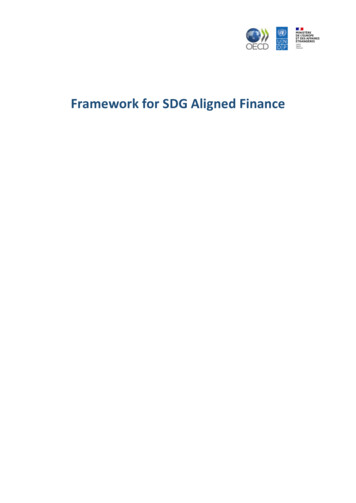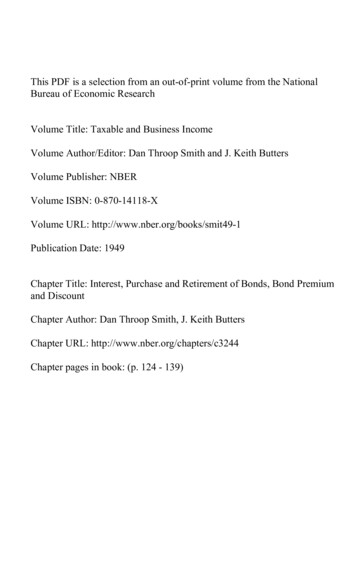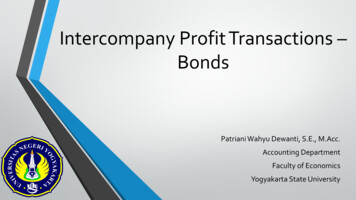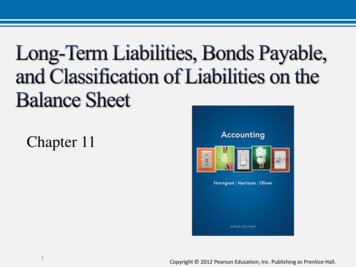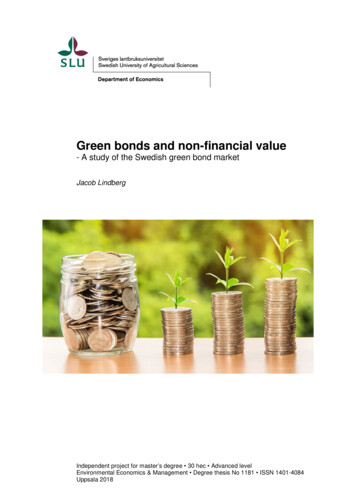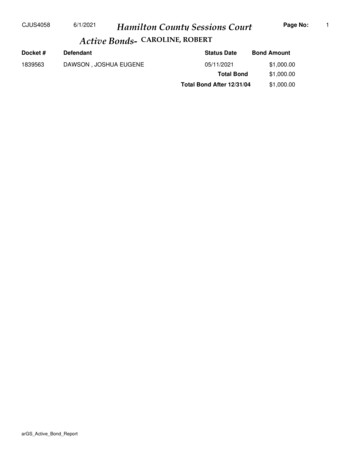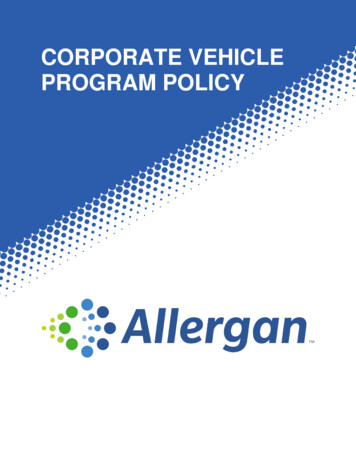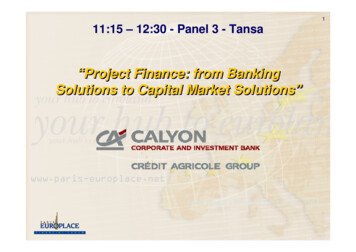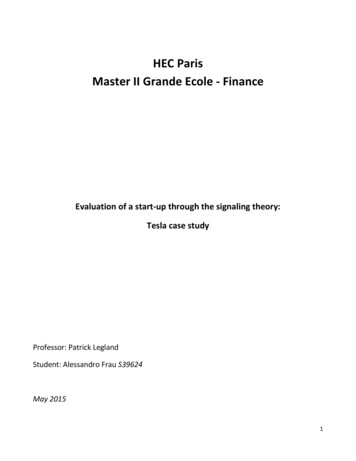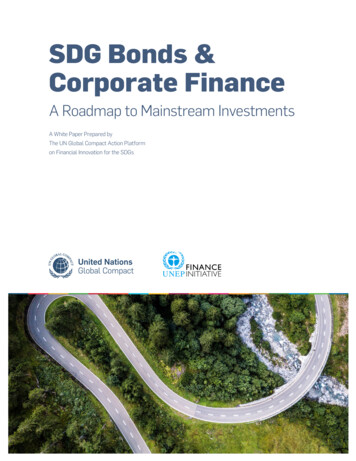
Transcription
SDG Bonds &Corporate FinanceA Roadmap to Mainstream InvestmentsA White Paper Prepared byThe UN Global Compact Action Platformon Financial Innovation for the SDGsa
b SDG BONDS & CORPORATE FINANCE: A ROADMAP TO MAINSTREAM INVESTMENTSABOUT THE UNITED NATIONSGLOBAL COMPACTAs a special initiative of the UN Secretary-General, the United Nations GlobalCompact is a call to companies everywhere to align their operations and strategieswith ten universal principles in the areas of human rights, labour, environment andanti-corruption. Launched in 2000, the mandate of the UN Global Compact is to guideand support the global business community in advancing UN goals and values throughresponsible corporate practices. With more than 9,500 companies and 3,000 nonbusiness signatories based in over 160 countries, and more than 70 Local Networks, itis the largest corporate sustainability initiative in the world.For more information, follow @globalcompact on social media and visit our website atwww.unglobalcompact.org.ABOUT THE ACTION PLATFORM ONFINANCIAL INNOVATION FOR THE SDGsThe UN Global Compact’s Financial Innovation for the SDGs Action Platform bringstogether a multi-disciplinary group of finance practitioners and experts to developinnovative private financial instruments that have the potential to direct private financetowards critical sustainability solutions. Led in collaboration with the Principles forResponsible Investment (PRI) and the United Nations Environment ProgrammeFinance Initiative (UNEP FI), the platform will develop guidance on impact investmentstrategies that support the Sustainable Development Goals (SDGs), map current andemerging financial instruments, and provide a laboratory for the development of newinnovative instruments. Ultimately, the goal is to improve the risk/return profile of SDGinvestments to attract institutional investors.DISCLAIMERThe inclusion of company names and/or examples in this publication is intendedstrictly for learning purposes and does not constitute an endorsement of the individualcompanies by the UN Global Compact.COPYRIGHT 2018
SDG BONDS & CORPORATE FINANCE: A ROADMAP TO MAINSTREAM INVESTMENTS iCONTENTSiiIntroductionvDefinitions and Disclaimervi Acknowledgements1Section I: Building a Market for Mainstream SDG Investments1 A. Defining a Broad Portfolio of Fixed-Income SDG Investments1 Corporate SDG Bonds (Non-Financial)2 SDG Bonds by Banks and Financial Institutions3 Asset-Backed and Project SDG Bonds3 Sovereign and Municipal SDG Bonds4B. Addressing a Gap in the Market for Corporate SDG Investments6 Expanding the Market for Asset- and Project-Based SDG Bonds Related to the SDGs7 Introducing an Integrated Model for Corporate SDG Finance9C. Leveraging Market Efficiency to Maximize Impact and Scale9 Leveraging the Scale, Discipline, and Efficiency of Broad Capital Markets10 Leveraging Sustainable Development as a Risk-Mitigating Factor11D. Matching SDG Investments with Mainstream Investors11 Assessing the Risk, Return and Impact Profile of Investors12 Assessing the Risk, Return and Impact Profile of Investments12 E. SDG Investments in Emerging Markets: A Focus on Sovereign Bonds, Foreign DirectInvestment, and Bank Loans16Section II: An Integrated Model for Corporate SDG Finance17Step 1. Developing a Credible Impact Theory17 Characteristics of a Credible SDG Impact Theory18 Suggested Elements of a Theory of Impact23Step 2. Measuring and Monitoring the Impact of SDG Investments23 Reflecting a Company’s Unique Theory of Impact25 Allowing for Comparability25 Leveraging the SDGs’ Targets and Indicators27Step 3. Integrating SDG Impact in Corporate Strategy and Governance28Step 4. Structuring Considerations for General-Purpose Corporate SDG Bonds28 Introducing a Model for General-Purpose SDG Bonds29 Progression Matrix to Maximize Credibility and Scale30 Adapt the Bond Structure to the Type of Issuer and Market Conditions31 Appendices31 Appendix A: Relevant SDGs, Targets and Indicators for Companies34 Appendix B: Examples of SDG Impact Theories and Strategies34 Danone36 Enel38 Iberdrola39 Pirelli41 Terna43 Appendix C. Qualifying Mainstream Asset Classes and Scaling Green and SustainableInvestments
ii SDG BONDS & CORPORATE FINANCE: A ROADMAP TO MAINSTREAM INVESTMENTSINTRODUCTIONIn September 2015, all 193 Member Statesof the United Nations (UN) adopted the 2030Agenda for Sustainable Development, a15-year plan to end extreme poverty, fightinequality and injustice, and protect ourplanet. At the heart of Agenda 2030 are the 17Sustainable Development Goals (SDGs) and169 underlying targets.According to the UN Commission on Trade andDevelopment (UNCTAD), achieving the SDGswill require between US 3 trillion and US 5trillion in investment annually in developingcountries alone. At today’s level of public andprivate investment, the Commission estimatesan annual shortfall of about US 2.5trillion. While additional public funds will benecessary to finance the SDGs, it is widelyacknowledged in the international communitythat the capital markets can play a key role inclosing the financing gap.According to some estimates, implementationof the goals will open market opportunitiesreaching trillions of dollars, creatinga significant pipeline of investmentopportunities. The Business Commission forSustainable Development finds in its flagshipreport, Better Business, Better World, that theSDGs provide the private sector with a newgrowth strategy that opens valuable marketopportunities. It identifies 60 sustainableand inclusive market “hotspots” in four keyeconomic sectors that are worth at leastUS 12 trillion: Energy US 4.3 trillion, CitiesUS 3.7 trillion, Food and AgricultureUS 2.3 trillion, and Health and Well-BeingUS 1.8 trillion.112At the same time, investor interest in theSDGs is growing. Many of the world’s largestinstitutional investors see them as a keyframework to fill the growing demandfor impact investments. CalPERS hascalled the SDGs a “gift to investors” and the17 goals have become a reference point forsustainability investment strategies for anumber of large institutional investors. Arecent PRI publication on the SDG InvestmentCase points out:Since the launch of the Principles forResponsible Investment in 2006, thepreamble to the Principles has said: “Werecognise that applying these Principlesmay better align investors with broaderobjectives of society.” Never before havethese “broader objectives of society”been more clearly defined than in theSDGs.2The confluence of these two trendssuggests that a market for mainstreamSDG investments could be created, withenough scale, liquidity and diversification,to attract large institutional investors andfinance a broad set of private- and publicsector activities in support of the SDGs.Efficient capital markets can play a key rolein encouraging companies and others toexperiment with and improve upon a widerange of solutions to ensure that the mosteffective approaches are discovered andfinanced.Better Business, Better World, Business Commission for Sustainable Development, January 2017.SDG Investment Case, Principles for Responsible Investment, 2017.
SDG BONDS & CORPORATE FINANCE: A ROADMAP TO MAINSTREAM INVESTMENTS iiiWith the release of SDG Bonds andCorporate Finance – A RoadmapTo Mainstream Investments, we arehoping to inspire and guide companies,governments, cities, and others involved inthe implementation of Agenda 2030 to tapinto the private capital markets and benefitfrom cheaper and more reliable funding. Ourgoal is also to inspire major players in theinvestment community, investors — banks andother financial institutions — to increase theirallocation of capital toward SDG investmentsand to contribute to lowering the cost ofcapital to finance the SDGs.We seek to introduce a flexible frameworkto support the many ways businesses andgovernments can contribute to the SDGs,while creating a large and diversified marketfor investors. In addition, we seek a paradigmshift in which companies and other issuerscan compete for capital based not only ontheir investment thesis, but also on theirimpact thesis and how they will use funds tocontribute to the SDGs.Our primary focus is on fixed-incomeproducts as a financing mechanism that canprovide access to large amounts of cheapercapital for a broad set of actors involved inthe realization of the SDGs, ranging fromcompanies, Governments, and cities toinfrastructure projects and public-privatepartnerships. Fixed income is also a longerterm, lower-risk asset class that matches theprofile of SDG activities and has enough scale— with US 6.7 trillion of annual issuance — tofill the SDG financing gap.3 We also see anopportunity to leverage the equity marketas a corollary to the corporate bond market.Another major focus is SDG financingin emerging markets since this is whereinvestments are most needed and whereaccess to capital is most limited andexpensive. In these markets, sovereign bondsand foreign direct investment (FDI) are themain source of external financing, in partbecause of their inherent stability. In leastdeveloped countries (LDCs), FDI is the primarysource of financing after official developmentassistance (ODA) and remittances.Multinational companies with significantoperations in emerging markets and accessto global capital markets can significantlycontribute to closing the SDG funding gapthrough FDI. By extension, corporatefinance can become a major source ofSDG investments through corporate bondsand equity that support an integrated SDGstrategy in emerging markets.This Roadmap is structured in two sections:section one addresses key considerationsin the creation of a market for mainstreamSDG investments; section two introduces anintegrated model for corporate SDG finance.Section one defines a broad portfolio ofSDG investments that can be financedthrough SDG bonds. We envision that a marketfor corporate SDG bonds could developquickly, as a growing number of companieswill require capital to pursue opportunitiesassociated with the SDGs, or to transition toa sustainable business model. There is alsoa large potential market around sovereign,municipal and project bonds that can supportthe implementation of countries’ nationalplans for the SDGs. Demand for SDG bondscould also develop around structured productsto de-risk and scale investments in publicprivate partnerships and blended capitalproducts.43 Source: The Future of Global Debt Issuance: 2025 Outlook, Aite Group, September 2017.4 Blended Finance is an approach to structured finance that enables development and philanthropic funding to mobilize private capital into a projector company that promotes development outcomes, by mitigating risk and/or ensuring commercial risk adjusted returns. World Economic Forum.
iv SDG BONDS & CORPORATE FINANCE: A ROADMAP TO MAINSTREAM INVESTMENTSSection one also identifies gaps in thecurrent market for corporate SDGinvestments and suggests several pathsforward. These include expanding the scopeof the asset- and project-based marketfor green, social and sustainability bonds.Another path is to introduce a model forcorporate SDG finance whereby corporatelevel SDG contributions are integrated intocompanies’ strategy and governance, and canbe financed by general-purpose bonds andequity.We then explore how a broad and liquidmarket can contribute to maximizingthe scale and credibility of SDGinvestments. This can be achieved throughthe self-disciplining effect of public marketsand risk mitigation inherent in sustainableinvestments.Lastly, we explore how a diversified market forSDG investments can attract the growing butequally diverse investor base interested in theSDGs, based on a trade-off between impactand risk/return considerations.Section two delves further into an integratedmodel for corporate SDG finance tosupport corporate-level contributions to theSDGs. We provide guidance on how companiescan develop a unique theory of impact anddevelop credible impact measurements thatcan be integrated into the company’s mainstrategy and governance procedures, as wellas its corporate finance strategy. Lastly, weintroduce considerations on how to structuregeneral-purpose corporate SDG bonds.An Integrated Model for Corporate SDG FinanceStep 1. Develop a credible SDG impact theoryStep 2. Measure and monitor the impact of SDG investmentsStep 3. Integrate SDG impact in corporate strategy and governanceStep 4. Structuring considerations for corporate SDG bonds
SDG BONDS & CORPORATE FINANCE: A ROADMAP TO MAINSTREAM INVESTMENTS vDEFINITIONS AND DISCLAIMERThe terms defined below are used descriptively with conceptual definitions to help theunderstanding of how public capital markets can contribute to financing the SDGs. Our purposeis not to introduce official names, standards, or principles related to any financial products.Over time, the market will establish clear labels and categories for these products. These willbe created as issuers and their advisers adopt designations that best reflect their strategy andinvestors promote categories that provide clear signals to the market and support portfolioconstruction.SDG Bonds: Broad category that includes use-of-proceed and general-purpose bonds eitherissued by companies, Governments, and municipalities, or for assets and projects.Use-of-proceed SDG Bonds: Bonds with strict accountability of the use of proceeds towardeligible green, social, or climate activities and a link to the SDGs. They are issued in accordancewith the Green and Social Bond Principles (ICMA) or the Climate Bond Standard (CBI). Use-ofproceed SDG bonds can be issued by companies, Governments and municipalities as well as forassets and projects. They can be unsecured, backed by the creditworthiness of the corporate orGovernment issuer. They can also be secured with collateral on a specific asset.General-purpose SDG Bonds: Bonds issued by companies that have adopted a corporate-levelstrategy to contribute to the SDGs and that are committed to providing accountability for thegeneral use of funds and corporate-level SDG impacts. General-purpose SDG bonds can also beissued by Governments and they are unsecured.SDG Equity: Common stock of companies that have adopted a corporate-level strategy tocontribute to the SDGs and that are committed to providing accountability for the general use ofcapital and corporate-level SDG impacts.Corporate SDG Finance: Strategic use of different financial instruments to fund corporatelevel SDG strategies, including (but not limited to) the instruments listed above.
vi SDG BONDS & CORPORATE FINANCE: A ROADMAP TO MAINSTREAM INVESTMENTSACKNOWLEDGEMENTSSDG Bonds and Corporate Finance – A Roadmap to Mainstream Investments is releasedas part of the UN Global Compact Leaders Summit 2018. It was prepared by the UN GlobalCompact Action Platform on Financial Innovation for the SDGs, a group of organizationsrepresenting the entire investment value chain, from corporate and sovereign issuers to banksand institutional investors. It also includes UN agencies, and development banks and agencies.We also acknowledge valuable comments and contributions from Danone, HSBC, and GarantiBank.The Action Platform on Financial Innovation for the SDGs develops guidance on impactinvestment strategies that support the Sustainable Development Goals. Additionally, it mapscurrent and emerging financial instruments and provides a laboratory for the creation of newinnovative instruments. The purpose is to improve the risk-return profile of SDG investments toattract institutional investors.Action Platform Members and Partners
SDG BONDS & CORPORATE FINANCE: A ROADMAP TO MAINSTREAM INVESTMENTS 1SECTION I: BUILDING AMARKET FOR MAINSTREAMSDG INVESTMENTSThe key to creating a market for mainstreamSDG investments is to ensure the marketis sufficiently large, liquid, diversified, andtransparent for institutional investors. In thissection, we e define a broad portfolio of SDGinvestments that can be financed throughSDG bonds. We also explore how a broad andliquid market can contribute to maximize thescale and credibility of SDG investments.We then introduce an alternate model forgeneral-purpose corporate SDG bonds toaccommodate a broader range of issuers.A. DEFINING A BROADPORTFOLIO OF FIXED-INCOMESDG INVESTMENTSThe immense financing gap for the SDGs, thetrillions of dollars in market opportunities, andthe multitude of actors involved in achievingthe SDGs all contribute to tremendousinvestment opportunities, many of which canbe financed through the bond market.In this section, we define a broad portfolioof fixed-income SDG investments, rangingfrom large corporations and banks developingmarket solutions for the SDGs, to nationaland subnational governments looking to fundpublic programs related to the SDGs. Thisportfolio also includes large infrastructureprojects and smaller investments that can bepooled together and securitized.Corporate SDG Bonds(Non-Financial)New business models, markets, or sourcesof payment for SDG-related activities canbecome attractive investment opportunitiesfor companies and can be financed throughcorporate bonds. Companies transitioningto these sustainable business models areexpected to have substantial capital needs forresearch and development, human resources,physical assets, and other corporate activities.This includes: Companies operating in prime SDG sectorsand geographies1 Companies adopting new circular orinclusive business models Companies addressing new markets andconsumers for sustainable goods andservices Financial institutions providing consumerfinance and other services that supportsustainable consumption or access toessential products and servicesCompanies can finance their SDG activitiesusing general funds raised through traditionalcorporate finance mechanisms. However,such financing makes it difficult for investorsto identify companies that meaningfullycontribute to the SDGs. Also, financing SDGrelated activities through generic financialproducts makes it hard to determine whetherthe funds are used for SDG-related activitiesand if the investment has a credible impact onSDGs.One solution is to introduce SDG-themedbonds with corporate governance mechanismsto ensure that investments are directedtoward SDG-related activities. This approachreveals the final impact of corporate activities(the ‘what’) as well as the way they wereexecuted (the ‘how’). The process of issuingsuch bonds provides an opportunity forcompanies to communicate with capitalmarkets and differentiate themselvesfrom less sustainable peers. Through bonddocumentation and structure, companies canformulate a credible theory and strategy forSDG impact. They can allocate specific assetsor resources to implement the strategy and1 Prime SDG sectors are those that contribute most to the SDGs including health, food, water & sanitation, energy, infrastructure, education, andfinance. Prime geographies depend on each goal but often include low- and middle-income countries.
2 SDG BONDS & CORPORATE FINANCE: A ROADMAP TO MAINSTREAM INVESTMENTScommit to credible governance mechanismsthat ensure transparent monitoring ofactivities and results.These corporate SDG bonds can take theform of use-of-proceed bonds wherebycompanies can identify specific assets orprojects that contribute to the SDGs andcommit to a strict accountability on use-ofproceed bonds. In the absence of such assetsand projects, or if companies are looking tofinance a more comprehensive SDG strategyat the corporate level, corporate SDG bondscan be issued as general-purpose bondswith a commitment to accountability on thegeneral use of proceeds and corporate-levelimpacts (general-purpose bonds).To date, there has not been any SDG bondissued by companies in real-economy sectors.However, some social bonds have been issuedby real-economy companies with social projectsthat contri
SDG Bonds and Corporate Finance – A Roadmap to Mainstream Investments is released as part of the UN Global Compact Leaders Summit 2018. It was prepared by the UN Global Compact Action Platform on Financial Innovation for the SDGs, a group of organizations representing the entire investment
